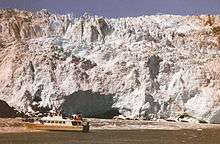Kenai Fjords National Park
Kenai Fjords National Park is a United States National Park in Southcentral Alaska.
Understand

History
Landscape
Kenai Fjords National Park is a geological wonderland where glaciers and ice caps meet the ocean. Comprising an edge of the Kenai Peninsula in south central Alaska near the town of Seward, the park is home to the Harding Icefield, one of the four major ice caps in the United States. The Icefield, which covers more than half of the national park's more than 700,000 acres (280,000 hectares), has carved long, steep-sided water valleys, called "fjords", forming the perfect habitat and aquatic environment for a wide array of marine wildlife. These plankton-rich waters are natural feeding grounds for whales on their long migrations north and south. Above sea level, the chiseled fjords reach toward the sky, home to millions of migratory birds.
Although the Harding Icefield and other topographic relics found in the park date back to the last ice age, the Kenai Fjords area is one of constant change and activity. The rugged coastline is constantly changed by the collision of the Pacific and North American tectonic plates. These forces deepen the fjords, lower the Kenai Mountain Range, and create spectacular landscapes.
Flora and fauna
Visitors can expect to see a wide variety of seabirds such as cormorants and puffins. There are also many marine mammals. Harbor seals and sea otters are frequently seen, there are islands which serve as haul-out spots for sea lions, and sightings of orca and humpback whales are common in the summer months. The cliffs around the fjords are home to mountain goats as well as terrestrial birds, including a sizable population of bald eagles.
Forests in the park are comprised mainly of spruce and hemlock trees. There is a wide variety of marine plant life as well.
Climate
Overcast and cool days are frequent in this maritime climate of abundant rain. Summer daytime temperatures range from the mid-40s to low 70s (F). The wet, stormy fall begins in September. Wool or synthetic clothing and sturdy rain gear - pants, coat and hat - are essential.
Get in
Access to the park is almost entirely through the town of Seward. Seward's airport is a single short runway, so there are no regularly scheduled flights. Most visitors arrive either by road or train from Anchorage, or on cruise ships.
Fees and permits

All boats offering tours must be approved by the park service. All entry fees will be covered by your tour ticket price. Expect to pay at least $100 per person.
Permits for public use cabins must be purchased in advance from park office at the Seward harbor. Cabin users are responsible for their own transportation to and from the cabin. Attempting to reach the remote cabins by kayak or other unpowered boats is not recommended.
Get around
There are no roads in the park. Most visitors take a tour by boat. There are numerous tour operators on the Seward waterfront. Tours are generally 4-6 hours and include a stop at a tidewater glacier, sea lion haul outs, seabirds rookeries, and lunch. Tours will vary their routes to maximize the visitors wildlife and glacier viewing opportunities. Tours may be cancelled or limited to a short trip inside Resurrection Bay if there is inclement weather at sea. There are also water taxis which can transport visitors to specific areas such as public-use cabins. Whichever method of access you use, be prepared for cold winds, even if it is warm in Seward. The icefield and it's glaciers can generate very strong, very cold winds at any time.
See
Do
Buy
Eat
Drink
Sleep
Lodging
Kenai Fjords Glacier Lodge: The only lodge within Kenai Fjords National Park. Nestled within a Native-owned wildlife sanctuary on the edge of a protected lagoon, Kenai Fjords Glacier Lodge and guest cabins enjoy stunning views of Pedersen Glacier.
Camping
Backcountry
Stay safe
Organized marine tours are the safest way to enjoy the park. If you intend to use your own boat or venture into the backcountry, do not depend on mobile phone service as a way to communicate if you do get into trouble. Satellite phones and/or GPS emergency locator beacons should be used by all parties. Flare guns are also recommended as a way to alert rescuers of your exact locations.
The waters in the park are extremely cold and can kill an adult human in a matter of minutes, especially the waters in the glacial fjords, which have sea ice in them year-round. If you are kayaking in the park, never travel alone, always be sure to file a plan with the park office, and be prepared for weather to force you to stay longer than intended. Winds and tides in the park can be fierce and unpredictable, only those very experienced at sea kayaking and wilderness survival should attempt any sort of float trip in the park.
Never closely approach or climb onto an iceberg. They can be extremely unstable and can roll or flip without warning. The glaciers and icefield should only be entered by persons properly trained and outfitted.
Never approach wild animals. There are black bears in some areas of the park who will defend their territory against interlopers. Be bear aware at all times on land, especially in the deep forest or near streams. Closely approaching any marine mammal is both prohibited and dangerous. Sea lions are known to become extremely aggressive if they feel a human is encroaching on their personal space. Adult males can weigh over 800 pounds (360 kg) and can move extremely fast in water. Whales breaching or other whale behaviors can generate waves that can tip small boats. While everyone enjoys seeing these spectacular animals, always leave a respectful safety buffer between you and them.
Go next